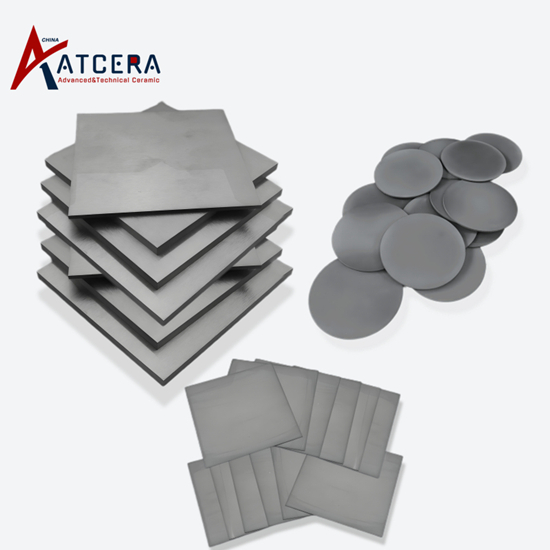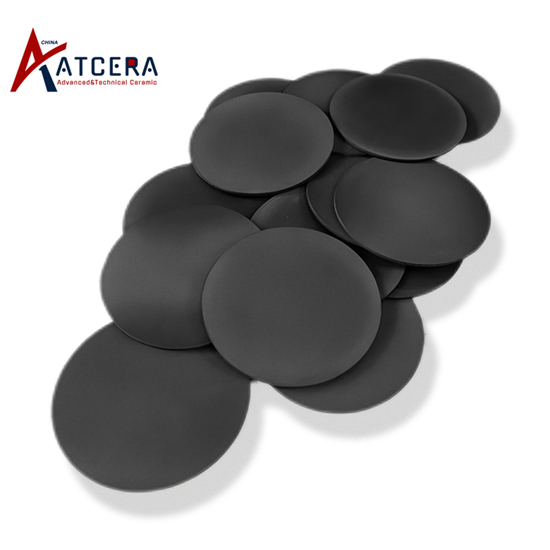ўБўК ЎєЎІўДўЕ ЎІўДЎ•ўДўГЎ™Ў±ўИўЖўКЎІЎ™ ЎІўДўЕЎ™ўВЎѓўЕЎ© ЎІўДЎѓўКўЖЎІўЕўКўГўКЎМ ўКўГўЕўЖ ўЕўБЎ™ЎІЎ≠ ЎІўДЎ®ўВЎІЎ° ўБўК ЎІўДўЕўВЎѓўЕЎ© ўБўК ЎІўДЎ≥ЎєўК ЎІўДЎѓЎ§ўИЎ® ўДўДЎІЎ®Ў™ўГЎІЎ±. ўЕЎє ЎІЎ≥Ў™ўЕЎ±ЎІЎ± ЎІўДЎ™ўГўЖўИўДўИЎђўКЎІ ўБўК ЎІўДЎ™ЎЈўИЎ± Ў®ўИЎ™ўКЎ±Ў© Ў≥Ў±ўКЎєЎ©ЎМ Ў™ЎЄўЗЎ± Ў±ўГЎІЎ¶Ў≤ Ў£ЎіЎ®ЎІўЗ ЎІўДўЕўИЎµўДЎІЎ™ Si3N4 ЎєЎІўДўКЎ© ЎІўДЎ£ЎѓЎІЎ° Ў®ЎІЎєЎ™Ў®ЎІЎ±ўЗЎІ ЎІўДЎ±ЎІЎ¶ЎѓЎ© ўБўК Ў•Ў≠ЎѓЎІЎЂ ЎЂўИЎ±Ў© ўБўК ЎІўДЎµўЖЎІЎєЎ©. Ў®ўБЎґўД ЎЂЎ®ЎІЎ™ўЗЎІ ЎІўДЎ≠Ў±ЎІЎ±ўК ЎІўДЎІЎ≥Ў™ЎЂўЖЎІЎ¶ўКЎМ ўИўВўИЎ™ўЗЎІ ЎІўДўЕўКўГЎІўЖўКўГўКЎ©ЎМ ўИЎЃЎµЎІЎ¶Ўµ ЎІўДЎєЎ≤ўД ЎІўДўГўЗЎ±Ў®ЎІЎ¶ўКЎМ Ў™ЎЈўДўВ Ў±ўГЎІЎ¶Ў≤ Si3N4 ЎІўДЎєўЖЎІўЖ ўДўДўВўИЎ© ЎІўДЎ≠ўВўКўВўКЎ© ўДўДЎ•ўДўГЎ™Ў±ўИўЖўКЎІЎ™ ЎІўДўЕЎ™ўВЎѓўЕЎ© Ў®ЎіўГўД ўДўЕ ўКЎ≥Ў®ўВ ўДўЗ ўЕЎЂўКўД.
ўИўЕўЖ ЎЃўДЎІўД ЎѓўЕЎђ Ў±ўГЎІЎ¶Ў≤ Si3N4 ўБўК ЎІўДЎ£ЎђўЗЎ≤Ў© ЎІўДЎ•ўДўГЎ™Ў±ўИўЖўКЎ©ЎМ Ў£ЎµЎ®Ў≠ ЎІўДўЕЎµўЖЎєўИўЖ ўВЎІЎѓЎ±ўКўЖ ЎєўДўЙ Ў™ЎђЎІўИЎ≤ Ў≠ЎѓўИЎѓ ЎІўДЎ£ЎѓЎІЎ° ўИЎІўДўГўБЎІЎ°Ў©. Ў™ЎєўЕўД ўЗЎ∞ўЗ ЎІўДЎ±ўГЎІЎ¶Ў≤ ЎєўДўЙ Ў™Ў≠Ў≥ўКўЖ ўВЎѓЎ±ЎІЎ™ ЎІўДЎ™ЎєЎІўЕўД ўЕЎє ЎІўДЎЈЎІўВЎ© ўДўДўЕўГўИўЖЎІЎ™ ЎІўДЎ•ўДўГЎ™Ў±ўИўЖўКЎ©ЎМ ўЕўЕЎІ ўКЎ™ўКЎ≠ ўЕЎєЎѓўДЎІЎ™ ўЖўВўД Ў£Ў≥Ў±Ўє ўДўДЎ®ўКЎІўЖЎІЎ™ ўИЎ™Ў≠Ў≥ўКўЖ ЎІўДЎ•ЎѓЎІЎ±Ў© ЎІўДЎ≠Ў±ЎІЎ±ўКЎ© ўИЎ≤ўКЎІЎѓЎ© ЎІўДўЕўИЎЂўИўВўКЎ©. Ў≥ўИЎІЎ° ўГЎІўЖ Ў∞ўДўГ ўБўК ЎІўДўЗўИЎІЎ™ўБ ЎІўДЎ∞ўГўКЎ©ЎМ Ў£ўИ Ў•ўДўГЎ™Ў±ўИўЖўКЎІЎ™ ЎІўДЎ≥ўКЎІЎ±ЎІЎ™ЎМ Ў£ўИ Ў™ЎЈЎ®ўКўВЎІЎ™ ЎІўДўБЎґЎІЎ° ЎІўДЎђўИўКЎМ Ў™ЎєўЕўД Ў±ўГЎІЎ¶Ў≤ Si3N4 ЎєўДўЙ Ў™ЎЇўКўКЎ± ЎІўДЎЈЎ±ўКўВЎ© ЎІўДЎ™ўК ўЖЎЃЎ™Ў®Ў± Ў®ўЗЎІ ЎІўДЎ™ўГўЖўИўДўИЎђўКЎІ.
ўЕЎє ЎІЎ≥Ў™ўЕЎ±ЎІЎ± ўЖўЕўИ ЎІўДЎЈўДЎ® ЎєўДўЙ ЎІўДЎ•ўДўГЎ™Ў±ўИўЖўКЎІЎ™ ЎІўДЎ≥Ў±ўКЎєЎ© ўИЎІўДўЕўИЎЂўИўВЎ© ўИЎІўДўЕўИўБЎ±Ў© ўДўДЎЈЎІўВЎ©ЎМ ўБЎ•ўЖ Ў±ўГЎІЎ¶Ў≤ Ў£ЎіЎ®ЎІўЗ ЎІўДўЕўИЎµўДЎІЎ™ Si3N4 Ў™Ў≥Ў™ЎєЎѓ ўДўВўКЎІЎѓЎ© ЎІўДЎµўЖЎІЎєЎ© Ў•ўДўЙ ЎІўДўЕЎ≥Ў™ўВЎ®ўД. ўЕЎ≤ўКЎђўЗЎІ ЎІўДўБЎ±ўКЎѓ ўЕўЖ ЎІўДўВўИЎ© ўИЎЃЎµЎІЎ¶Ўµ ЎІўДЎєЎ≤ўД ўКЎђЎєўДўЗЎІ ЎєўЖЎµЎ±ўЛЎІ Ў£Ў≥ЎІЎ≥ўКўЛЎІ ўБўК Ў™ЎЈўИўКЎ± ЎІўДЎ£ЎђўЗЎ≤Ў© ЎІўДЎ•ўДўГЎ™Ў±ўИўЖўКЎ© ЎІўДўЕЎ™ЎЈўИЎ±Ў©.
ўДЎ∞ЎІЎМ ЎІЎ≥Ў™ЎєЎѓўИЎІ ўИЎІЎ≥Ў™ЎєЎѓўИЎІ ўДЎІЎ≥Ў™ўГЎіЎІўБ ЎІўДЎ•ўЕўГЎІўЖўКЎІЎ™ ЎІўДўДЎІўЕЎ≠ЎѓўИЎѓЎ© ЎІўДЎ™ўК Ў™ўИўБЎ±ўЗЎІ Ў±ўГЎІЎ¶Ў≤ Ў£ЎіЎ®ЎІўЗ ЎІўДўЕўИЎµўДЎІЎ™ Si3N4 ЎєўДўЙ ЎІўДЎЈЎІўИўДЎ©. ўЕЎ≥Ў™ўВЎ®ўД ЎІўДЎ•ўДўГЎ™Ў±ўИўЖўКЎІЎ™ ЎІўДўЕЎ™ўВЎѓўЕЎ© ўКЎ®ЎѓЎ£ ўЕўЖ ўЗўЖЎІ.
ўЕЎ≤ЎІўКЎІ Ў±ўГЎІЎ¶Ў≤ Ў£ЎіЎ®ЎІўЗ ЎІўДўЕўИЎµўДЎІЎ™ Si3N4
Ў®Ў±Ў≤Ў™ Ў±ўГЎІЎ¶Ў≤ Ў£ЎіЎ®ЎІўЗ ЎІўДўЕўИЎµўДЎІЎ™ ўЕўЖ ўЖўКЎ™Ў±ўКЎѓ ЎІўДЎ≥ўКўДўКўГўИўЖ (Si3N4) ўГЎ®ЎѓўКўД ўДўВўИЎІЎєЎѓ ЎІўДўДЎєЎ®Ў© ўБўК ЎєЎІўДўЕ ЎІўДЎ•ўДўГЎ™Ў±ўИўЖўКЎІЎ™ ЎІўДўЕЎ™ўВЎѓўЕЎ©ЎМ Ў≠ўКЎЂ Ў™ўВЎѓўЕ ЎІўДЎєЎѓўКЎѓ ўЕўЖ ЎІўДўЕЎ≤ЎІўКЎІ ЎІўДЎ™ўК Ў™ўПЎ≠ЎѓЎЂ ЎЂўИЎ±Ў© ўБўК ўЗЎ∞ўЗ ЎІўДЎµўЖЎІЎєЎ©. Ў•Ў≠ЎѓўЙ ЎІўДўЕЎ≤ЎІўКЎІ ЎІўДЎ£Ў≥ЎІЎ≥ўКЎ© ўДЎ±ўГЎІЎ¶Ў≤ Si3N4 ўЗўК ЎЂЎ®ЎІЎ™ўЗЎІ ЎІўДЎ≠Ў±ЎІЎ±ўК ЎІўДЎІЎ≥Ў™ЎЂўЖЎІЎ¶ўК. ЎєўДўЙ ЎєўГЎ≥ ўЕўИЎІЎѓ Ў£ЎіЎ®ЎІўЗ ЎІўДўЕўИЎµўДЎІЎ™ ЎІўДЎ™ўВўДўКЎѓўКЎ©ЎМ ўКўЕўГўЖ ўДўА Si3N4 Ў™Ў≠ўЕўД ЎѓЎ±ЎђЎІЎ™ ЎІўДЎ≠Ў±ЎІЎ±Ў© ЎІўДЎєЎІўДўКЎ© ЎѓўИўЖ ЎІўДўЕЎ≥ЎІЎ≥ Ў®Ў≥ўДЎІўЕЎ™ўЗЎІ ЎІўДўЗўКўГўДўКЎ© Ў£ўИ ЎЃЎµЎІЎ¶ЎµўЗЎІ ЎІўДўГўЗЎ±Ў®ЎІЎ¶ўКЎ©. Ў™ЎєЎѓ ўЗЎ∞ўЗ ЎІўДўЕЎ±ўИўЖЎ© ЎІўДЎ≠Ў±ЎІЎ±ўКЎ© Ў£ўЕЎ±ўЛЎІ Ў®ЎІўДЎЇ ЎІўДЎ£ўЗўЕўКЎ© ўБўК ЎІўДЎ™ЎЈЎ®ўКўВЎІЎ™ ЎІўДЎ™ўК Ў™Ў™ЎєЎ±Ўґ ўБўКўЗЎІ ЎІўДўЕўГўИўЖЎІЎ™ ЎІўДЎ•ўДўГЎ™Ў±ўИўЖўКЎ© ўДЎ≠Ў±ЎІЎ±Ў© ЎіЎѓўКЎѓЎ©ЎМ ўГўЕЎІ ўЗўИ ЎІўДЎ≠ЎІўД ўБўК Ў•ўДўГЎ™Ў±ўИўЖўКЎІЎ™ ЎІўДЎЈЎІўВЎ©ЎМ ўИЎІўДЎ£ЎђўЗЎ≤Ў© ЎєЎІўДўКЎ© ЎІўДЎ™Ў±ЎѓЎѓЎМ ўИЎ•ўДўГЎ™Ў±ўИўЖўКЎІЎ™ ЎІўДЎ≥ўКЎІЎ±ЎІЎ™.
ЎІўДўЕўКЎ≤Ў© ЎІўДЎ±Ў¶ўКЎ≥ўКЎ© ЎІўДЎ£ЎЃЎ±ўЙ ўДЎ±ўГЎІЎ¶Ў≤ Si3N4 ўЗўК ўВўИЎ™ўЗЎІ ЎІўДўЕўКўГЎІўЖўКўГўКЎ© ЎІўДЎІЎ≥Ў™ЎЂўЖЎІЎ¶ўКЎ©. Ў™ЎіЎ™ўЗЎ± ўЗЎ∞ўЗ ЎІўДЎ±ўГЎІЎ¶Ў≤ Ў®ўВЎѓЎ±Ў™ўЗЎІ ЎєўДўЙ Ў™Ў≠ўЕўД ўЕЎ≥Ў™ўИўКЎІЎ™ ЎєЎІўДўКЎ© ўЕўЖ ЎІўДЎґЎЇЎЈ ўИЎІўДЎ•ЎђўЗЎІЎѓЎМ ўЕўЕЎІ ўКЎђЎєўДўЗЎІ ЎЃўКЎІЎ±ўЛЎІ ўЕЎЂЎІўДўКўЛЎІ ўДўДЎ™ЎЈЎ®ўКўВЎІЎ™ ЎІўДЎ™ўК Ў™ўГўИўЖ ўБўКўЗЎІ ЎІўДўЕЎ™ЎІўЖЎ© ўИЎІўДўЕўИЎЂўИўВўКЎ© Ў∞ЎІЎ™ Ў£ўЗўЕўКЎ© ўВЎµўИўЙ. Ў™ўПЎ™Ў±ЎђўЕ ўЗЎ∞ўЗ ЎІўДўВўИЎ© ЎІўДўЕўКўГЎІўЖўКўГўКЎ© Ў£ўКЎґўЛЎІ Ў•ўДўЙ Ў™Ў≠Ў≥ўКўЖ Ў™Ў®ЎѓўКЎѓ ЎІўДЎ≠Ў±ЎІЎ±Ў©ЎМ Ў≠ўКЎЂ ўКўЕўГўЖ ўДўДЎ±ўГЎІЎ¶Ў≤ ўЖўВўД ЎІўДЎ≠Ў±ЎІЎ±Ў© Ў®ЎіўГўД ўБЎєЎІўД Ў®ЎєўКЎѓўЛЎІ ЎєўЖ ЎІўДўЕўГўИўЖЎІЎ™ ЎІўДЎ•ўДўГЎ™Ў±ўИўЖўКЎ© ЎІўДЎ≠Ў≥ЎІЎ≥Ў©ЎМ ўЕўЕЎІ ўКЎєЎ≤Ў≤ ЎІўДЎ£ЎѓЎІЎ° ЎІўДЎєЎІўЕ ўДўДўЖЎЄЎІўЕ ўИЎЈўИўД ЎІўДЎєўЕЎ±.
Furthermore, Si3N4 semiconductor substrates possess excellent electrical insulation properties, which is a critical factor in the design and fabrication of high-performance electronic devices. These substrates effectively isolate electrical signals, preventing cross-talk and ensuring signal integrity, which is essential for applications such as radio frequency (RF) and high-speed digital circuits. This insulating property also contributes to the improved power handling capabilities of Si3N4-based electronic devices, enabling them to operate at higher voltages and power levels without compromising reliability.
Applications of Si3N4 semiconductor substrates in advanced electronics
The exceptional properties of Si3N4 semiconductor substrates have made them an indispensable component in a wide range of advanced electronic applications. In the realm of power electronics, Si3N4 substrates are widely used in the manufacture of high-power transistors, inverters, and motor drives. These substrates provide the necessary thermal management and electrical insulation, allowing power electronic devices to operate at higher voltages and switching frequencies, resulting in improved efficiency and reliability.
In the automotive industry, Si3N4 semiconductor substrates have become increasingly prevalent, particularly in the design of electronic control units (ECUs) and other safety-critical components. The robust mechanical properties and thermal stability of these substrates ensure that automotive electronics can withstand the harsh environmental conditions encountered in vehicles, such as extreme temperatures, vibrations, and shocks. This, in turn, enhances the overall reliability and safety of modern automobiles.
The aerospace and defense sectors have also embraced the use of Si3N4 semiconductor substrates, as these applications often demand the highest levels of performance and reliability. In these industries, Si3N4 substrates are utilized in a variety of electronic systems, including radar, avionics, and satellite communications. The unique combination of thermal, mechanical, and electrical properties offered by Si3N4 substrates enables the development of advanced electronic systems that can operate reliably in the demanding environments encountered in aerospace and defense applications.

The future of Si3N4 semiconductor substrates in the electronics industry
As the demand for faster, more efficient, and more reliable electronic devices continues to grow, the role of Si3N4 semiconductor substrates in shaping the future of the electronics industry cannot be overstated. With the ever-increasing complexity and power requirements of modern electronic systems, the exceptional properties of Si3N4 substrates make them an increasingly attractive choice for manufacturers and designers.
Looking ahead, the integration of Si3N4 semiconductor substrates into a wide range of electronic devices is expected to accelerate. From next-generation smartphones and wearables to cutting-edge industrial automation and renewable energy systems, Si3N4 substrates will play a crucial role in enabling the development of high-performance, energy-efficient, and reliable electronic components.
Furthermore, the ongoing research and development in the field of Si3N4 substrate manufacturing processes are expected to drive further advancements in the technology. Improvements in material quality, manufacturing techniques, and cost-effectiveness will likely lead to the widespread adoption of Si3N4 substrates across the electronics industry, solidifying their position as the preferred choice for a wide range of applications.
Manufacturing process of Si3N4 semiconductor substrates
The manufacturing of high-quality Si3N4 semiconductor substrates involves a complex and meticulous process that requires precise control over various parameters. The production of Si3N4 substrates typically begins with the synthesis of the raw material, silicon nitride, through a chemical reaction between silicon and nitrogen.
One of the most common methods for producing Si3N4 is the chemical vapor deposition (CVD) process, where silicon and nitrogen-containing precursor gases are introduced into a reaction chamber and subjected to high temperatures. This process allows for the controlled deposition of a thin, uniform layer of Si3N4 on a suitable substrate, such as silicon or sapphire.
Following the Si3N4 deposition, the substrate undergoes a series of precision machining and polishing steps to ensure a smooth, defect-free surface. This surface preparation is crucial, as it directly impacts the performance and reliability of the electronic devices that will be fabricated on the substrate.
To further enhance the properties of the Si3N4 substrate, various post-processing techniques may be employed, such as thermal annealing or the application of protective coatings. These additional steps help to optimize the substrate's thermal, mechanical, and electrical characteristics, making it better suited for specific electronic applications.
The manufacturing of Si3N4 semiconductor substrates requires a high level of expertise, advanced equipment, and stringent quality control measures to ensure the production of consistently reliable and high-performing materials. As the demand for these substrates continues to grow, manufacturers are continuously innovating and improving their processes to meet the ever-evolving needs of the electronics industry.
Key properties and characteristics of Si3N4 semiconductor substrates
The exceptional properties and characteristics of Si3N4 semiconductor substrates are what make them so valuable in the world of advanced electronics. One of the most notable features of Si3N4 is its exceptional thermal stability, which allows it to withstand high temperatures without compromising its structural integrity or electrical performance. This thermal resilience is particularly crucial in power electronics and high-power applications, where the substrate must be able to effectively dissipate heat generated by the electronic components.
In addition to its thermal stability, Si3N4 is renowned for its exceptional mechanical strength and hardness. These properties contribute to the substrate's ability to withstand high levels of stress and strain, making it an ideal choice for applications where durability and reliability are paramount, such as in automotive electronics and aerospace systems.
Another key characteristic of Si3N4 semiconductor substrates is their excellent electrical insulation properties. These substrates are highly effective at isolating electrical signals, preventing cross-talk and ensuring signal integrity, which is essential for high-frequency and high-speed digital circuits. This insulating capability also allows Si3N4-based electronic devices to operate at higher voltages and power levels without compromising reliability.
Furthermore, Si3N4 substrates exhibit a low coefficient of thermal expansion, which closely matches that of the semiconductor materials commonly used in electronic devices. This thermal compatibility helps to minimize the risk of thermal-induced stresses and failures, contributing to the overall reliability and performance of the electronic systems.
The combination of these exceptional properties вАУ thermal stability, mechanical strength, electrical insulation, and thermal compatibility вАУ makes Si3N4 semiconductor substrates a highly sought-after material in the electronics industry, enabling the development of cutting-edge electronic devices that are more powerful, efficient, and reliable than ever before.
Challenges and limitations of Si3N4 semiconductor substrates
While Si3N4 semiconductor substrates offer numerous advantages, they are not without their challenges and limitations. One of the primary challenges in the widespread adoption of Si3N4 substrates is the relatively higher cost compared to traditional semiconductor materials, such as silicon or gallium arsenide.
The manufacturing process of Si3N4 substrates is complex and requires specialized equipment, as well as a high level of expertise and quality control measures. This, in turn, can drive up the overall production costs, making Si3N4 substrates less accessible for some manufacturers, especially in price-sensitive markets.
Another limitation of Si3N4 substrates is their relatively lower thermal conductivity compared to some other semiconductor materials, such as silicon carbide (SiC) or diamond. While Si3N4 substrates exhibit excellent thermal stability, their ability to dissipate heat may be slightly less efficient in certain high-power applications, where the thermal management requirements are particularly demanding.
Additionally, the manufacturing of large-diameter Si3N4 substrates can be more challenging and may result in higher defect rates, limiting the availability of large-scale wafers for high-volume production. This can be a constraint for manufacturers who require larger substrate sizes to meet their specific design and production needs.
Despite these challenges, the electronics industry is continuously working to address the limitations of Si3N4 substrates through ongoing research and development.
Advancements in manufacturing processes, material engineering, and cost-reduction strategies are expected to help overcome these obstacles and further drive the adoption of Si3N4 substrates in the future.
Comparison of Si3N4 semiconductor substrates with other semiconductor materials
When it comes to semiconductor substrates, Si3N4 stands out as a unique and highly capable material, offering a combination of properties that are often unmatched by other semiconductor materials. One of the primary advantages of Si3N4 over traditional silicon (Si) substrates is its superior thermal stability and mechanical strength.
While silicon is a widely used semiconductor material, it can be susceptible to thermal degradation and mechanical failures at high temperatures or under high-stress conditions. In contrast, Si3N4 substrates can withstand much higher temperatures and exhibit greater resistance to mechanical stress, making them a better choice for power electronics, high-frequency, and harsh-environment applications.
Another semiconductor material that has gained significant attention in recent years is silicon carbide (SiC). Like Si3N4, SiC also offers excellent thermal stability and mechanical strength, making it a viable alternative for advanced electronic applications. However, Si3N4 substrates generally have a lower coefficient of thermal expansion, which can be advantageous in terms of thermal compatibility with semiconductor devices and reduced thermal-induced stresses.
Gallium nitride (GaN) is another semiconductor material that has seen increasing adoption in high-power and high-frequency electronics. While GaN-based devices can offer excellent performance, they often require specialized substrate materials, such as sapphire or SiC, to support their unique properties. In this context, Si3N4 substrates can serve as a cost-effective and compatible alternative, providing a suitable platform for the integration of GaN-based components.
In terms of electrical insulation properties, Si3N4 substrates outperform many other semiconductor materials, including silicon and gallium arsenide (GaAs). This superior insulation capability allows Si3N4-based electronic devices to operate at higher voltages and switching frequencies, improving overall efficiency and performance.
Overall, the unique combination of thermal, mechanical, and electrical characteristics of Si3N4 semiconductor substrates makes them a highly versatile and attractive choice for a wide range of advanced electronic applications, where the demand for high-performance, reliable, and efficient devices continues to grow.

Importance of high-performance Si3N4 semiconductor substrates in the development of advanced electronics
The role of high-performance Si3N4 semiconductor substrates in the development of advanced electronics cannot be overstated. As the electronics industry continues to push the boundaries of performance, efficiency, and reliability, these exceptional substrates have become an essential component in the quest for technological breakthroughs.
One of the key drivers behind the importance of Si3N4 substrates is the growing demand for power-dense and energy-efficient electronic devices. In industries such as automotive, aerospace, and renewable energy, the ability to handle high power levels while maintaining thermal stability and reliability is crucial. Si3N4 substrates, with their exceptional thermal management capabilities and mechanical strength, enable the design and manufacture of electronic components that can operate reliably under these demanding conditions.
Furthermore, the insulating properties of Si3N4 substrates are crucial in the development of high-frequency and high-speed electronic devices, such as those used in telecommunications, radar systems, and advanced computing. By effectively isolating electrical signals and preventing cross-talk, Si3N4 substrates help to ensure the integrity and performance of these mission-critical electronic systems.
As the world becomes increasingly reliant on advanced electronics, the need for reliable, durable, and efficient devices has never been more pressing. Si3N4 semiconductor substrates play a pivotal role in meeting these demands, enabling the creation of innovative electronic products that are better equipped to handle the challenges of the modern world.
From smartphones and wearables to industrial automation and renewable energy systems, the integration of high-performance Si3N4 substrates is transforming the electronics industry, paving the way for a future where advanced electronics are more powerful, efficient, and reliable than ever before.
Conclusion: The potential and outlook of Si3N4 semiconductor substrates in the electronics industry
ўЕЎє ЎІЎ≥Ў™ўЕЎ±ЎІЎ± ЎµўЖЎІЎєЎ© ЎІўДЎ•ўДўГЎ™Ў±ўИўЖўКЎІЎ™ ўБўК ЎІўДЎ™ЎЈўИЎ± Ў®ўИЎ™ўКЎ±Ў© Ў≥Ў±ўКЎєЎ©ЎМ Ў£ЎµЎ®Ў≠ ЎѓўИЎ± Ў±ўГЎІЎ¶Ў≤ Ў£ЎіЎ®ЎІўЗ ЎІўДўЕўИЎµўДЎІЎ™ Si3N4 ўБўК Ў™ЎіўГўКўД ўЕЎ≥Ў™ўВЎ®ўД ЎІўДЎ•ўДўГЎ™Ў±ўИўЖўКЎІЎ™ ЎІўДўЕЎ™ўВЎѓўЕЎ© ўИЎІЎґЎ≠ўЛЎІ Ў®ЎіўГўД ўЕЎ™Ў≤ЎІўКЎѓ. Ў•ўЖ ўЗЎ∞ўЗ ЎІўДўЕўИЎІЎѓ ЎІўДЎІЎ≥Ў™ЎЂўЖЎІЎ¶ўКЎ©ЎМ ўЕЎє ЎЂЎ®ЎІЎ™ўЗЎІ ЎІўДЎ≠Ў±ЎІЎ±ўК ЎІўДЎ∞ўК ўДЎІ ўЕЎЂўКўД ўДўЗЎМ ўИўВўИЎ™ўЗЎІ ЎІўДўЕўКўГЎІўЖўКўГўКЎ©ЎМ ўИЎЃЎµЎІЎ¶Ўµ ЎІўДЎєЎ≤ўД ЎІўДўГўЗЎ±Ў®ЎІЎ¶ўКЎМ ўЕўЗўКЎ£Ў© ўДўДЎєЎ® ЎѓўИЎ± ўЕЎ≠ўИЎ±ўК ўБўК Ў™ЎЈўИўКЎ± ЎІўДЎ£ЎђўЗЎ≤Ў© ЎІўДЎ•ўДўГЎ™Ў±ўИўЖўКЎ© ЎІўДўЕЎ™ЎЈўИЎ±Ў© ЎІўДЎ™ўК Ў™ўГўИўЖ Ў£ўГЎЂЎ± ўВўИЎ© ўИўГўБЎІЎ°Ў© ўИўЕўИЎЂўИўВўКЎ© ўЕўЖ Ў£ўК ўИўВЎ™ ўЕЎґўЙ.
Ў•ўЖ Ў•ўЕўГЎІўЖЎІЎ™ Ў±ўГЎІЎ¶Ў≤ Si3N4 ўЗЎІЎ¶ўДЎ©ЎМ Ў≠ўКЎЂ ўКўЕўГўЖ ЎѓўЕЎђўЗЎІ Ў®Ў≥ўДЎІЎ≥Ў© ўБўК ўЕЎђўЕўИЎєЎ© ўИЎІЎ≥ЎєЎ© ўЕўЖ ЎІўДЎ™ЎЈЎ®ўКўВЎІЎ™ ЎІўДЎ•ўДўГЎ™Ў±ўИўЖўКЎ©ЎМ Ў®ЎѓЎ°ўЛЎІ ўЕўЖ Ў•ўДўГЎ™Ў±ўИўЖўКЎІЎ™ ЎІўДЎЈЎІўВЎ© ўИЎІўДЎ£ЎђўЗЎ≤Ў© ЎєЎІўДўКЎ© ЎІўДЎ™Ў±ЎѓЎѓ Ў•ўДўЙ Ў£ўЖЎЄўЕЎ© ЎІўДЎ≥ўКЎІЎ±ЎІЎ™ ўИЎІўДўБЎґЎІЎ°. ўЕЎє ЎІЎ≥Ў™ўЕЎ±ЎІЎ± ўЖўЕўИ ЎІўДЎЈўДЎ® ЎєўДўЙ ЎІўДЎ•ўДўГЎ™Ў±ўИўЖўКЎІЎ™ ЎІўДЎ≥Ў±ўКЎєЎ© ўИЎІўДўЕўИЎЂўИўВЎ© ўИЎІўДўЕўИўБЎ±Ў© ўДўДЎЈЎІўВЎ©ЎМ Ў≥Ў™ЎЄўД Ў±ўГЎІЎ¶Ў≤ Si3N4 ўБўК ЎЈўДўКЎєЎ© ЎІўДЎІЎ®Ў™ўГЎІЎ± ЎІўДЎ™ўГўЖўИўДўИЎђўКЎМ ўЕўЕЎІ ўКЎ™ўКЎ≠ ўДўДўЕЎµўЖЎєўКўЖ ЎѓўБЎє Ў≠ЎѓўИЎѓ ўЕЎІ ўЗўИ ўЕўЕўГўЖ.
ўИЎ®ЎІўДўЖЎЄЎ± Ў•ўДўЙ ЎІўДўЕЎ≥Ў™ўВЎ®ўДЎМ ўБЎ•ўЖ ўЕЎ≥Ў™ўВЎ®ўД Ў±ўГЎІЎ¶Ў≤ Ў£ЎіЎ®ЎІўЗ ЎІўДўЕўИЎµўДЎІЎ™ Si3N4 ўБўК ЎµўЖЎІЎєЎ© ЎІўДЎ•ўДўГЎ™Ў±ўИўЖўКЎІЎ™ ўЕўДўКЎ° Ў®ЎІўДўИЎєўИЎѓ. ўИўЕўЖ ЎІўДўЕЎ™ўИўВЎє Ў£ўЖ Ў™Ў§ЎѓўК ЎђўЗўИЎѓ ЎІўДЎ®Ў≠ЎЂ ўИЎІўДЎ™ЎЈўИўКЎ± ЎІўДўЕЎ≥Ў™ўЕЎ±Ў© Ў•ўДўЙ ЎѓўБЎє ЎІўДўЕЎ≤ўКЎѓ ўЕўЖ ЎІўДЎ™ўВЎѓўЕ ўБўК ЎђўИЎѓЎ© ЎІўДўЕўИЎІЎѓЎМ ўИЎєўЕўДўКЎІЎ™ ЎІўДЎ™ЎµўЖўКЎєЎМ ўИўБЎєЎІўДўКЎ© ЎІўДЎ™ўГўДўБЎ©ЎМ ўЕўЕЎІ ўКЎ§ЎѓўК ўБўК ЎІўДўЖўЗЎІўКЎ© Ў•ўДўЙ ЎІЎєЎ™ўЕЎІЎѓ ўЗЎ∞ўЗ ЎІўДЎ±ўГЎІЎ¶Ў≤ ЎєўДўЙ ўЖЎЈЎІўВ ўИЎІЎ≥Ўє ўБўК ЎђўЕўКЎє Ў£ўЖЎ≠ЎІЎ° ЎІўДЎµўЖЎІЎєЎ©.
ўЕЎє ЎІЎ≥Ў™ўЕЎ±ЎІЎ± Ў™ЎЈўИЎ± ўЕЎіўЗЎѓ ЎІўДЎ•ўДўГЎ™Ў±ўИўЖўКЎІЎ™ЎМ ўБЎ•ўЖ Ў™ЎєЎѓЎѓ ЎІЎ≥Ў™ЎЃЎѓЎІўЕЎІЎ™ ўИЎ£ЎѓЎІЎ° Ў±ўГЎІЎ¶Ў≤ Si3N4 Ў≥ўКЎђЎєўДўЗЎІ ЎєўЖЎµЎ±ўЛЎІ ўДЎІ ЎЇўЖўЙ ЎєўЖўЗ Ў®ЎіўГўД ўЕЎ™Ў≤ЎІўКЎѓ ўБўК ЎІўДЎ®Ў≠ЎЂ ЎєўЖ Ў£ЎђўЗЎ≤Ў© Ў•ўДўГЎ™Ў±ўИўЖўКЎ© ўЕЎ™ЎЈўИЎ±Ў© ўИЎєЎІўДўКЎ© ЎІўДЎ£ЎѓЎІЎ°. ўЕўЖ ЎІўДўЗўИЎІЎ™ўБ ЎІўДЎ∞ўГўКЎ© ЎІўДЎ£ўЖўКўВЎ© ўБўК ЎђўКўИЎ®ўЖЎІ Ў•ўДўЙ Ў£ўЖЎЄўЕЎ© Ў•ўДўГЎ™Ў±ўИўЖўКЎІЎ™ ЎІўДЎЈўКЎ±ЎІўЖ ЎІўДўЕЎ™ўВЎѓўЕЎ© ўБўК ЎЈЎІЎ¶Ў±ЎІЎ™ўЖЎІЎМ Ў≥ўКўГўИўЖ Ў™Ў£ЎЂўКЎ± Ў±ўГЎІЎ¶Ў≤ Si3N4 ўЕЎ≠Ў≥ўИЎ≥ўЛЎІ ЎєЎ®Ў± ўЕЎђўЕўИЎєЎ© ўИЎІЎ≥ЎєЎ© ўЕўЖ ЎІўДЎµўЖЎІЎєЎІЎ™ЎМ ўЕўЕЎІ Ў≥ўКЎіўГўД ўЕЎ≥Ў™ўВЎ®ўД ЎІўДЎ™ўГўЖўИўДўИЎђўКЎІ ўГўЕЎІ ўЖЎєЎ±ўБўЗЎІ.
ўБўК ЎІўДЎЃЎ™ЎІўЕЎМ ўБЎ•ўЖ Ў•ўЕўГЎІўЖЎІЎ™ Ў±ўГЎІЎ¶Ў≤ Ў£ЎіЎ®ЎІўЗ ЎІўДўЕўИЎµўДЎІЎ™ Si3N4 ўБўК ЎµўЖЎІЎєЎ© ЎІўДЎ•ўДўГЎ™Ў±ўИўЖўКЎІЎ™ ўДЎІ Ў≠ЎѓўИЎѓ ўДўЗЎІ Ў≠ўВўЛЎІ. ўИўЕЎє ЎІЎ≥Ў™ўЕЎ±ЎІЎ± Ў™Ў≤ЎІўКЎѓ ЎІўДЎЈўДЎ® ЎєўДўЙ Ў£ЎђўЗЎ≤Ў© Ў•ўДўГЎ™Ў±ўИўЖўКЎ© Ў£Ў≥Ў±Ўє ўИЎ£ўГЎЂЎ± ўГўБЎІЎ°Ў© ўИўЕўИЎЂўИўВўКЎ©ЎМ ўБЎ•ўЖ ўЗЎ∞ўЗ ЎІўДўЕўИЎІЎѓ ЎІўДЎІЎ≥Ў™ЎЂўЖЎІЎ¶ўКЎ© Ў≥Ў™ўДЎєЎ® Ў®ўДЎІ ЎіўГ ЎѓўИЎ±ўЛЎІ ўЕЎ≠ўИЎ±ўКўЛЎІ ўБўК ЎІўДЎѓЎЃўИўД ўБўК ЎєЎµЎ± ЎђЎѓўКЎѓ ўЕўЖ ЎІўДЎ•ўДўГЎ™Ў±ўИўЖўКЎІЎ™ ЎІўДўЕЎ™ўВЎѓўЕЎ©ЎМ ўИЎ™ЎЇўКўКЎ± ЎІўДЎЈЎ±ўКўВЎ© ЎІўДЎ™ўК ўЖЎ™ўБЎІЎєўД Ў®ўЗЎІ ўИўЖЎЃЎ™Ў®Ў± ЎІўДЎєЎІўДўЕ ўЕўЖ Ў≠ўИўДўЖЎІ.


























